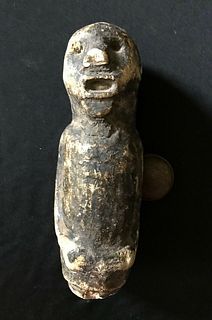Fossilized Branchiosaurus Salamandroides in Matrix
Lot 160
About Seller
Artemis Fine Arts
686 S Taylor Ave, Ste 106
Louisville, CO 80027
United States
Selling antiquities, ancient and ethnographic art online since 1993, Artemis Gallery specializes in Classical Antiquities (Egyptian, Greek, Roman, Near Eastern), Asian, Pre-Columbian, African / Tribal / Oceanographic art. Our extensive inventory includes pottery, stone, metal, wood, glass and textil...Read more
Estimate:
$300 - $450
Absentee vs Live bid
Two ways to bid:
- Leave a max absentee bid and the platform will bid on your behalf up to your maximum bid during the live auction.
- Bid live during the auction and your bids will be submitted real-time to the auctioneer.
Bid Increments
| Price | Bid Increment |
|---|---|
| $0 | $25 |
| $300 | $50 |
| $1,000 | $100 |
| $2,000 | $250 |
| $5,000 | $500 |
| $10,000 | $1,000 |
| $20,000 | $2,500 |
| $50,000 | $5,000 |
| $100,000 | $10,000 |
| $200,000 | $20,000 |
About Auction
By Artemis Fine Arts
Sep 2, 2021
Set Reminder
2021-09-02 12:00:00
2021-09-02 12:00:00
America/New_York
Bidsquare
Bidsquare : Summer Art Auction | Fine | Folk | Fun
https://www.bidsquare.com/auctions/artemis-gallery/summer-art-auction-fine-folk-fun-7395
Featuring visual treats from around the world, and back in time to present day - fine art, folk art, and fun artsy objects. Paintings. Sculptures. Textiles. More. Convenient in-house shipping. Artemis Fine Arts info@artemisfinearts.com
Featuring visual treats from around the world, and back in time to present day - fine art, folk art, and fun artsy objects. Paintings. Sculptures. Textiles. More. Convenient in-house shipping. Artemis Fine Arts info@artemisfinearts.com
- Lot Description
Western Europe, Germany, Pfalz, Niederkirchen Beds, Permian period, ca. 299 to 252.2 million years ago. This is an adorable skeleton of a fossilized Branchiosaurus salamandroides, a prehistoric amphibian species. The slender body and tail are elongated with spindly legs at the sides. This creature would have propelled itself through the water, relying on the tail for power. The head is a diamond shape and would have had gills for life in water. One fascinating note: larger Branchiosaurus fossils show increased ossification of bones that suggests how Branchiosaurus might be the larval stage of a larger amphibian, such as Eryops, while others hypothesize that Branchiosaurus retains gills into adulthood. These water dwelling creatures could be transitional, equipped for the water, but possibly growing into semi-terrestrial creatures. This is a remarkable piece of the evolutionary puzzle that is preserved in this matrix! Size of fossil: 2.5" L x 0.25" W (6.4 cm x 0.6 cm); matrix: 3.25" L x 2.3" W (8.3 cm x 5.8 cm); case: 8.25" L x 6.25" W (21 cm x 15.9 cm)
Provenance: ex-Stein collection, Bloomfield Hills, Michigan, USA, acquired prior to 2010
All items legal to buy/sell under U.S. Statute covering cultural patrimony Code 2600, CHAPTER 14, and are guaranteed to be as described or your money back.
A Certificate of Authenticity will accompany all winning bids.
PLEASE NOTE: Due to recent increases of shipments being seized by Australian & German customs (even for items with pre-UNESCO provenance), we will no longer ship most antiquities and ancient Chinese art to Australia & Germany. For categories of items that are acceptable to ship to Australia or Germany, please contact us directly or work with your local customs brokerage firm.
Display stands not described as included/custom in the item description are for photography purposes only and will not be included with the item upon shipping.
#164102The matrix is thin and delicate. Faint skeletal remains with dark pigments added to enhance visibility. Displayed in a modern Riker case.Condition
- Shipping Info
-
All shipping is handled in-house for your convenience. Your invoice from Artemis Gallery will include shipping calculation instructions. If in doubt, please inquire BEFORE bidding for estimated shipping costs for individual items.
-
- Buyer's Premium



 EUR
EUR CAD
CAD AUD
AUD GBP
GBP MXN
MXN HKD
HKD CNY
CNY MYR
MYR SEK
SEK SGD
SGD CHF
CHF THB
THB









